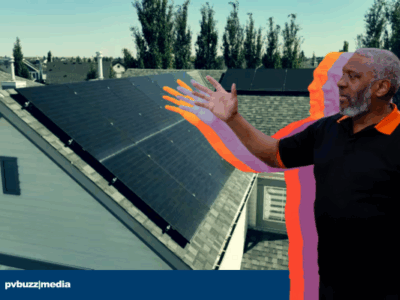OTTAWA & NIAGARA FALLS, Ontario | CanSIA —
For the last five years, since the Canadian Electricity Association has been tracking Canadians’ sentiments on the subject, solar has remained the preferred fuel source for providing electricity for Canadians.
Every day it is getting easier to make the argument for solar. “We’ve known for years that solar was the energy darling,” says John Gorman, President and CEO of Canadian Solar Industries Association (CanSIA). “Canadians really respond to solar’s reputation for clean, free, powerful energy. But for many years, as the technology was being proven, solar earned a reputation for being expensive. The market has matured and solar prices have come down tremendously. Today, solar generated electricity is becoming cost competitive with other sources of generation.” Gorman cautions, “Continued deliberate investment in solar over the next decade, and in solar-enabling technologies like batteries, will ensure Canadians’ overwhelming preference to bring more solar into their electricity supply mix will be realized without major impacts on their energy bills.”
“The price of solar energy in Ontario is an innovation story,” says Gorman. “Looking at the cost curve since 2009, capital costs for utility-scale solar will have fallen by 65% between 2009 and 2016. With equipment costs expected to continue to fall, grid parity – or price-competitiveness with other fuel sources – is, for the first time, an achievable goal for solar energy. The notion that solar is expensive is an outdated myth, and a holdover from the old paradigm. We’re pleased to see that many Ontarians already understand this (41%), or are at least open to the idea.” Supply-mix planning should now consider solar’s future cost trajectory, and account for the steeply reducing cost of solar.
The new economics of solar can be attributed to falling costs for solar panels and modules, business model innovation that allows for more flexibility in ownership, favorable political and regulatory environments, and increased access to low-cost capital. The fact that the fuel source is free ensures that input costs will never rise.
“Eighty-six percent of Ontarians favour seeing the future energy needs of the province being met by solar (58% very favourable, 28% somewhat favourable). It’s incumbent upon this government to find ways to deliver on the promise of solar, and to continue to be creative in the ways it creates opportunities for more solar in our electricity supply mix. Providing some predictability on procurement beyond 2017 will be critical.”
Ontario is a leader in solar power generation. Fully 43 per cent of all new capacity additions in Ontario were solar (337 MW). Globally, solar overtook wind as the most invested-in renewable energy in 2011. Investment in solar in Canada jumped 47 per cent in 2014. “We are gratified to see that Ontario has learned a lot about the value of solar and, whether on rooftops or in rural fields, want more solar in their electricity supply mix as we travel the road to our clean energy future.” Eighty-nine per cent of Ontarians support solar on rooftops while 79% support solar farms in rural fields.
Solar Ontario will be held May 25-27 at Hilton’s Fallsview Casino Resort in Niagara Falls. The Gandalf Group’s Principal Partner, David Herle, will present findings of recent polling of Ontarians, conducted for CanSIA, at a session entitled “Envisioning the Future of Ontario’s Electricity System” from 10:00 – 11:30 on Tuesday May 26, during a panel he shares with JoAnne Butler, Vice-President, Market and Resource Development for the Independent Electricity System Operator (IESO), and Lisa DeMarco who, like Herle, sits on the Ontario government’s climate change advisory group, the Climate Action Group.
“More than three quarters (77%) of Ontarians believe that their provincial government needs to invest in more solar-powered electricity generation, and would like to see government policy that encourages companies to make use of solar energy to power their operations (83%). Fully 77 per cent would like to see the government invest more in solar powered electricity and in technologies that enable solar power. Further, they would like to see (75% support) the Ontario government reinvesting revenues from the proposed Cap-and-Trade system of carbon emissions pricing into solar-enabling technologies,” reports Herle.
“The fundamental benefits Ontarians feel they would receive from a greater adoption of solar energy, is improved air quality (79 % much or somewhat better), which is also near the top of Ontarians’ economic and social priorities (79% very important),” adds Herle. “Those who voted Wynne’s Liberals into power are looking to government to pursue opportunities presented by the solar industry. Most Ontario Liberal voters believe more solar will lead to better air quality (91%), fighting climate change (93%) and would allow Ontario to show itself as a leader in high tech sectors and in innovation (80%).”
Eight in ten Ontarians believe that the clean-tech sector, like solar energy, will be important to the province’s economy and employment over the next decade, on par with manufacturing (79%) and ahead of auto assembly (69%). “Ontarians are certainly conscious of costs, whether it’s electricity rates or cost of living generally. It will be important for the industry to communicate more about how much costs of solar technology have declined and how advancements including energy storage can harness solar more efficiently,” concludes Herle.
See the complete survey report here.
Note: This survey of Ontarians about solar energy, technology and policies was fielded with 837 adult Ontarians between May 1 and May 8th, 2015, using a randomly-recruited, non-opt-in online panel, resulting in a margin of error of ±3.39% 19/20.














Comments